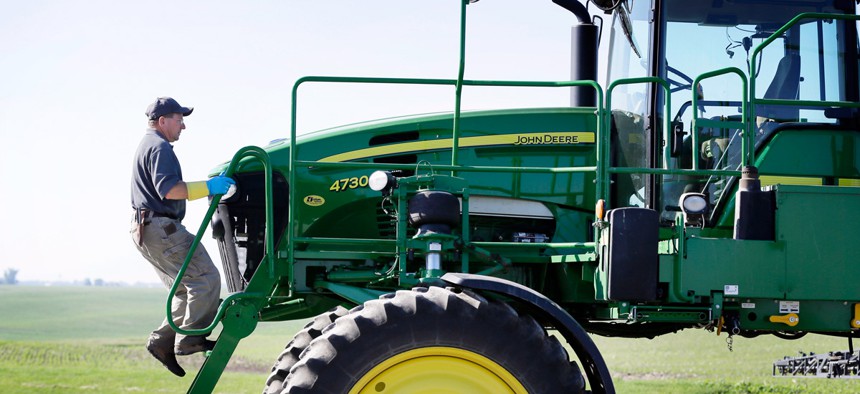Watchdog Points to Poor Management in Multimillion-Dollar IT Failure at USDA

Ray Gaesser climbs onto a sprayer on his farm, Wednesday, June 11, 2014, near Corning, Iowa. Charlie Neibergall/AP
USDA's Farm Service Agency has met only a fraction of its goals on an ambitious IT modernization project, according to the Government Accountability Office.
A decade-long IT modernization at the Agriculture Department has so far delivered only a fraction of its intended capabilities, a new report says.
The Farm Service Agency, which manages benefits programs for farmers and ranchers, including providing emergency assistance for livestock or incentives for resource conservation, has been trying to modernize its IT systems since 2004. Known as MIDAS, the “Modernize and Innovative the Delivery of Agricultural Systems” program aimed to replace obsolete computers and consolidate software.
But the program has been stymied by poor management and uncertain program goals, among other factors, according to a report from the Government Accountability Office.
Until FSA fixes those problems, " the agency will be at an increased risk of producing additional projects with cost overruns and schedule slippages while contributing little to mission-related outcomes," the report said. MIDAS wasn't properly governed, GAO found, in part because USDA's office of the CIO "did not ensure that MIDAS followed its policies and guidance for IT governance."
As a result, some benefit management systems are still paper based, the report said, meaning farmers and ranchers still have to submit documents in person at FSA service centers.
MIDAS was supposed to replace computers dating back to the 1980s, to make data more accessible to farmers and ranchers and to streamline applications, among other improvements.
Between 2004 and 2010, FSA changed the direction of MIDAS several times before picking a technical solution, GAO found. For instance, though the agency drafted requirements in 2004, officials decided in 2006 the custom solution wouldn't meet future needs and stopped development. They later decided to buy commercial resource planning software. In 2008, FSA chose SAP's software and then "decided to accelerate the time frame for implementing the solution from the 10 years originally planned to two years”.
After several abrupt changes over a decade and two software releases, in July 2014 the USDA secretary decided to stop MIDAS. Projections indicated the project's baseline budget would have grown from $330 million to $659 million by 2016. (A TechStat review in 2012 prompted the office of the CIO to ask for a new baseline cost estimate by January 2013, but FSA did not meet that deadline, GAO found.)
GAO recommended the USDA secretary direct the FSA administrator to better manage IT projects, encouraging post-implementation reviews and document lessons learned for the MIDAS investment, among other steps to prevent future failures.
According to a statement provided to Nextgov, USDA "continues to successfully work through management and budget challenges" related to MIDAS, but its inspector general "found that MIDAS has increased functionality in the field and oversight has improved during the past two years. The IG also believes that USDA’s decision to cease MIDAS development in July 2014 was appropriate.”
Still, the software releases have so far only met about 20 percent of their intended capabilities, according to Dave Powner, GAO's director for information technology management issues and author of the report.
Lack of oversight from the CIO's office contributed to MIDAS' uneven development, he said. New legislation such as the Federal IT Acquisition Reform Act "is a major attempt to give CIOs more authority, he said, "but that comes with responsibility" to prevent management failures. "That's probably the most important thing when you look at a program like MIDAS."





